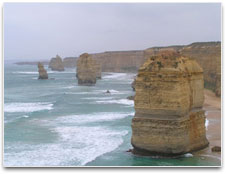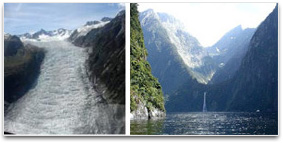This focus idea is explored through:
Contrasting student and scientific views
Student everyday experiences
 The difficult notion of the enormous expanse of geological time is far beyond what most students and many adults can conceptualise. Time spans as immense as millions, hundreds of millions or billions of years, carry little meaning for students, and hence students form understandings of the Earth’s history very different from those of scientists.
The difficult notion of the enormous expanse of geological time is far beyond what most students and many adults can conceptualise. Time spans as immense as millions, hundreds of millions or billions of years, carry little meaning for students, and hence students form understandings of the Earth’s history very different from those of scientists.
Students often confuse or attempt to compare the notions of human historical time periods (in the order of centuries or millennia) with vast geological time scales. They frequently describe very short time periods for geological processes like rock and mountain formation, and perceive the erosion that results in the creation of canyons and valleys as occurring within human time scales. Students often fail to appreciate that although most geological events occur very slowly, the immense time scales involved allow vast and dramatic physical changes to the Earth’s surface to eventuate.
Further confusion can be created by the less widely held student view that humans have existed for most of geological time or the religious belief held by a few that the age of the Earth is very, very much less than that predicted by current scientific evidence. Students often overlook the fact that land animals have been present for only a small fraction of the Earth’s geological age and humans for an even smaller fraction.
Other views held by students include perceptions that:
- the appearance of life and the formation of the Earth occurred at the same time
- the Earth hasn’t changed – how it is now is how it has always been, e.g. landforms such as mountains, rivers, seas have always existed in their present form. No mountains are forming or being removed by erosion at present
- mountains are formed very quickly from processes like earthquakes and volcanoes
- soil has always been there, and all soil was formed when the Earth formed
- soil is formed rapidly (from rotting organic matter such as dead leaves and plants).
Research: Blake (2005), Dove (1998),Trend (2001), Marques & Thompson (1997), Kusnick (2002), Phillips (1991)
Scientific view
Current evidence, based on terrestrial and astrophysical data and radioactive isotope dating, suggests the solar system formed (along with our Earth) around 4,540 million years ago. Recent astronomical data confirms that this event was many billions of years after the formation of the universe during the Big Bang. Since the Earth’s formation, continents have been continuously moving across its surface, changing their positions compared to each other. Mountain ranges have been formed only to be eroded away to reform new mountain ranges many times.
The processes which cause these changes (the movement of tectonic plates) continue to operate today. E.g. the Indian tectonic plate is pushing north under the Eurasian plate at a rate of about 5cm per year, resulting in the creation of the Himalayan mountain range. The movement of these plates is so slow that these speeds can only be determined by periodic satellite measurements. The very slow movement of tectonic plates is a central idea in geology that explains many phenomena such as mountain building, earthquakes and the folding and faulting we see in rock strata. For more about these ideas see the focus idea
Structure of the Earth.
Sedimentary rocks often contain fossils that record details of the existence of organisms that lived long ago. One difficulty with obtaining very old fossils is that the encasing rocks must have undergone negligible erosion or remelting since the original deposition of the rocks. The oldest known rocks on Earth are around 3.8 billion years old.
Researching the time at which the first unicellular life evolved is very complex. Currently the oldest fossil evidence found (3.6 billion years old) confirms that life was in existence approximately 950 million years after the formation of the Earth. This implies that life originated some time before this. For at least the next 2,000 million years after the oldest fossil evidence, only fossils of unicellular organisms such as cyanobacteria have been found, suggesting that these were the only life forms present for this period of time.
See websites listed under
Further resources to extend your understanding.
Critical teaching ideas
- The history of the Earth has occurred over an immense time scale. This scale is so far outside our experiences that it is very hard to conceive.
- Geological processes are extremely slow. However, because of the immense lengths of time involved, huge physical changes do occur - mountains are created and destroyed, continents form, break up and move over the surface of the Earth, coastlines change and rivers and glaciers erode huge valleys.
- Most of the rocks we see today have been formed and eroded many times.
- Like geological time, the evolution of life forms has occurred over a large time scale.
 Explore the relationships between ideas about geological time in the
Concept Development Maps – Changes in the Earth’s Surface and Plate Tectonics.
Explore the relationships between ideas about geological time in the
Concept Development Maps – Changes in the Earth’s Surface and Plate Tectonics.
 The vastness of geological time is fundamental to conveying to students an understanding of the dynamic nature of the Earth’s geology. Most students are capable of comprehending time spans of greater than a century or two and have an appreciation of human historical time scales of millennia. For example, the majority of students are comfortable with dealing with time spans involving the ancient Greek or Roman civilisations. However, when asked to deal with time scales of millions of years students and adults find they have little comprehension or experience of working with such vast numbers. Geological time scales take us beyond human experience and indeed back well before human existence. The idea that the Earth has existed for the majority of its time since formation without humans is often difficult to grasp; this difficulty needs to be explicitly discussed with students. Building an appreciation of geological time is fundamental to students achieving an understanding of geological processes such as mountain formation and erosion. Some useful examples of very dynamic landforms include the Grand Canyon, glacial valleys, the southwest Victorian coast around Port Campbell and the “Twelve Apostles”.
The vastness of geological time is fundamental to conveying to students an understanding of the dynamic nature of the Earth’s geology. Most students are capable of comprehending time spans of greater than a century or two and have an appreciation of human historical time scales of millennia. For example, the majority of students are comfortable with dealing with time spans involving the ancient Greek or Roman civilisations. However, when asked to deal with time scales of millions of years students and adults find they have little comprehension or experience of working with such vast numbers. Geological time scales take us beyond human experience and indeed back well before human existence. The idea that the Earth has existed for the majority of its time since formation without humans is often difficult to grasp; this difficulty needs to be explicitly discussed with students. Building an appreciation of geological time is fundamental to students achieving an understanding of geological processes such as mountain formation and erosion. Some useful examples of very dynamic landforms include the Grand Canyon, glacial valleys, the southwest Victorian coast around Port Campbell and the “Twelve Apostles”.
Some of the more significant events in a brief geological time scale (mya = million years ago) are listed in the table below:
| Time scale | Significant event |
|---|
| 12 000 – 18 000 mya | Formation of the universe by the ‘Big Bang’ |
| 4540 mya | Formation of the solar system including the Earth |
| 4000 mya | Early formation of continents and tectonic plates |
| 3700 mya | First primitive unicellular life forms |
| 1500 mya | First evidence of advanced cell structures |
| 542-520 mya | Proliferation and diversification of multicellular life forms |
| 490 mya | First green plants and fungi emerge on land |
| 420 mya | First land animals |
| 330 mya | Large primitive trees appear |
| 320 mya | First reptiles |
| 250 mya | Up to 95% of life on Earth becomes extinct |
| 230 mya | First dinosaurs appeared |
| 150 mya | Gondwanan land mass starts to break up |
| 150 mya | Monotremes, marsupials and placental mammals appear |
| 65 mya | Mass extinctions, end of the dinosaurs |
| 55 mya | Indian plate starts to collide with Asia, Himalayas start to form |
| 5 mya | First human like life forms |
| 0.06 mya | First record of aboriginal tribes in Victoria |
| 0.05 mya | Construction of the Egyptian pyramids |
| 0.0002 mya | Arrival of first Europeans in Australia |
Research: Trend (2001)
Teaching activities
In teaching about the vastness of geological time it is fundamental to create a visual representation for students to better appreciate the magnitude of this time scale and the relative positioning of critical events in the Earth’s history. There are many ways that this can be done; a few are suggested below.
Challenge some existing ideas
Students need to gain a concept of geological change and the long time periods involved.
Students could be asked to imagine that the school buildings were fenced off and abandoned. What would they look like in 10 years, 100 years, 1000 years, or a million years and so on? Encourage the students to draw images or write about the changes they would predict to occur over time. Provide some images of modern, old and ancient buildings constructed at different times to help them appreciate the changes that may happen with time. E.g. Port Arthur prison in Tasmania, the Cambodian Angkor Wat temple and the Egyptian pyramids.
Students can be shown images of fossil shells in mountainous locations. Ask them to provide explanations for how the shells could be deposited in such a location. Discuss the deposition of fossils in marine environments and the process of mountain building needed to raise the fossil bearing rocks. Have students focus on the time scale needed for such events to occur.
 Most students will be familiar with the formation of stalactites and stalagmites in caves. Have them investigate how long these formations take to form.
Most students will be familiar with the formation of stalactites and stalagmites in caves. Have them investigate how long these formations take to form.
Students can view photos of landforms and asked how long they may take to form. Examples include the Grand Canyon in the USA, Fox glacier and glacial Hanging Valley in New Zealand and the Mitchell River silt jetties in the Victorian Gippsland Lakes.
Promote reflection on and clarification of existing ideas
Students can be asked questions about a number of significant events in Earth's history (see the events listed in the table above) and encouraged to place them on a visual representation of a time line. It may be best to ask the questions one at a time – as some provide clues to earlier ones. Questions could include:
- What do you think the first organism to appear looked like?
- When do you think the first bacteria appeared?
- When do you think animals emerged from the sea to walk on land?
- When do you think the dinosaurs roamed the Earth in great numbers?
- When do you think the first humans appeared?
- How long ago do you think the Earth first formed?
Collect evidence for analysis
Like the focus idea,
Structure of the Earth, this focus idea is rich with easily located and interesting stories about past scientists that show how they build explanations using many kinds of evidence for things that cannot be directly observed. These explanations include many ‘big ideas’, for example the Big Bang theory, the formation of stars, the extinction of dinosaurs, continental drift and ice ages. Using a focus of ‘How could they know when they were not there?’ different groups could select a theory that interests them, research it and prepare a presentation to the class. The presentation could be in the form of a role play of relevant argument between scientists who may hold different opinions.
See Helman (1998) for ideas on continental drift.
Collect evidence for analysis
Students are usually interested in dinosaurs and often know a good deal about them. Groups of students can be asked to research dinosaurs of different periods and collect data about the time in which they lived, the positions of the continents at the time and the climatic conditions of the period. There are many websites available such as the one below with a wealth of information. Data can be presented on overheads or using PowerPoint presentations to the class to build up a picture of changing conditions over time.
Clarify and consolidate ideas
Students can construct a timeline using the major events in Earth's history provided in the table above. They can also research other events to add to the list such as dinosaur extinctions and mountain building. A convenient scale is 2cm = 10 million years.
For a more dramatic effect a football oval of approximately 100m diameter could be used to represent different events. To cover all Earth history a scale of 2cm = one million years needs to be used. Students can position themselves at different significant points.
A4 sheets can be stuck together using a scale of 1mm = one million years. Students can write in or place photos or diagrams of significant events such as first fish, first mammals and formation of the Himalayas on the time lines.
Promote reflection on how students' ideas have changed
Students can be shown their original time lines and asked to say what they would now change as a result of what they have learned. They can be asked to construct their own conversions to illustrate geologic time. For example if the last 600 million years of Earth history is represented on a one year calendar when would such events as the dinosaur extinction, or the first humans happen?
Further resources
Websites
-
Earth Science Literacy Initiative – this short resource developed by the American Association for the Advancement of Science provides an overview of the big ideas in Earth Science.
-
UCMP Cyanobacteria: Fossil Record – provides more information about the oldest cyanobacteria fossils found so far in Western Australia.
-
Prehistoric Time Line – this National Geographic website is a useful site for students to obtain information on how to create a geological timeline.
-
Geological Time - this Smithsonian National Museum of Natural History site provides information on the formation of the Earth and major geological and evolutionary events.